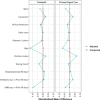The comparative effectiveness of telehealth versus primary care and collection of urine cultures on outcome in urinary tract infection
- PMID: 40696629
- PMCID: PMC12282790
- DOI: 10.1097/MD.0000000000043172
The comparative effectiveness of telehealth versus primary care and collection of urine cultures on outcome in urinary tract infection
Abstract
Studies of urinary tract infection (UTI) treatment in telehealth settings have primarily evaluated young, healthy females. Urine culture collection is less common in telehealth settings but is recommended for all patients with potentially complicated infection. The aims of this study were: (1) to compare UTI-related clinical failure between telehealth and in-person primary care settings, and (2) evaluate if urine culture (UC) collection impacted UTI-related failure in patients with risk for antibiotic resistant infection. A retrospective cohort study of outpatients diagnosed with UTI between 2019 and 2021 in the Department of Veterans Affairs system was conducted. Inclusion required a telehealth or primary care visit with UTI International Classification of Diseases-Clinical Modification 10th revision code documentation and an antibiotic dispensed. Patients with recent UTI, concurrent indications for antibiotics, or where asymptomatic bacteriuria treatment was appropriate were excluded. Treatment failure was defined as combination of a new UTI-related outpatient visit or hospitalization that occurred between 3 to 30 days after the antibiotic dispense date. Antibiotic exposure data, covariates, hospitalization, and UC history were obtained. Overlap weighting and generalized estimating equation models estimated the relative risk of failure for clinical setting and for UC collection versus no collection. There were 16,266 telehealth and 29,296 primary care patient-visits evaluated. The adjusted relative risk (±95% CI) of failure for telehealth relative to primary care was [0.87 (0.70, 1.08)]. An interaction between setting and age ≥65 [1.45 (1.12, 1.87)] indicated higher failure for elderly patients treated for UTI in telehealth. Urine culture collection was associated with increased risk of failure for patients treated in telehealth [2.06 (1.56, 2.72)]; however, an interaction between UC collection and prior antibiotic exposure ≤90 days indicated a protective effect in both telehealth [0.70 (0.53, 0.93)] and primary care [0.77 (0.60, 0.99)] settings. Overall, no difference in the clinical failure rate for UTI treatment between telehealth and primary care was observed. However, elderly patients treated for UTI in telehealth experienced higher failure relative to in-person primary care. Patients with recent prior antibiotic exposure in both settings had lower clinical failure rates when UCs were collected.
Keywords: comparative effectiveness; microbial culture; telehealth; urinary tract infection.
Copyright © 2025 the Author(s). Published by Wolters Kluwer Health, Inc.
Conflict of interest statement
The authors have no conflicts of interest to disclose.
Figures



Similar articles
-
Clinical effectiveness and cost-effectiveness of tests for the diagnosis and investigation of urinary tract infection in children: a systematic review and economic model.Health Technol Assess. 2006 Oct;10(36):iii-iv, xi-xiii, 1-154. doi: 10.3310/hta10360. Health Technol Assess. 2006. PMID: 17014747
-
Prescription of Controlled Substances: Benefits and Risks.2025 Jul 6. In: StatPearls [Internet]. Treasure Island (FL): StatPearls Publishing; 2025 Jan–. 2025 Jul 6. In: StatPearls [Internet]. Treasure Island (FL): StatPearls Publishing; 2025 Jan–. PMID: 30726003 Free Books & Documents.
-
Probiotics for preventing urinary tract infection in people with neuropathic bladder.Cochrane Database Syst Rev. 2017 Sep 8;9(9):CD010723. doi: 10.1002/14651858.CD010723.pub2. Cochrane Database Syst Rev. 2017. PMID: 28884476 Free PMC article.
-
Probiotics for preventing urinary tract infections in adults and children.Cochrane Database Syst Rev. 2015 Dec 23;2015(12):CD008772. doi: 10.1002/14651858.CD008772.pub2. Cochrane Database Syst Rev. 2015. PMID: 26695595 Free PMC article.
-
Antibiotics for treating lower urinary tract infection in children.Cochrane Database Syst Rev. 2012 Aug 15;2012(8):CD006857. doi: 10.1002/14651858.CD006857.pub2. Cochrane Database Syst Rev. 2012. PMID: 22895956 Free PMC article.
References
-
- Anon. Reduce the rate of hospital admissions for urinary tract infections among older adults-OA 07. Healthy People 2030. https://health.gov/healthypeople/objectives-and-data/browse-objectives/i.... Accessed February 7, 2025.
-
- Gupta K, Hooton TM, Naber KG, et al. International clinical practice guidelines for the treatment of acute uncomplicated cystitis and pyelonephritis in women: a 2010 update by the Infectious Diseases Society of America and the European Society for Microbiology and Infectious Diseases. Clin Infect Dis. 2011;52:e103–20. - PubMed
-
- Nelson Z, Aslan AT, Beahm NP, et al. Guidelines for the prevention, diagnosis, and management of urinary tract infections in pediatrics and adults: a wiki guidelines group consensus statement. JAMA Netw Open. 2024;7:e2444495. - PubMed
-
- Anon. Public comment IDSA guideline on management and treatment of complicated urinary tract infections. Infectious Diseases Society of America. https://www.idsociety.org/practice-guideline/complicated-uti/. Accessed April 3, 2025.
-
- Gupta K. Acute simple cystitis in male adults. https://www.uptodate.com/contents/acute-simple-cystitis-in-male-adults? Accessed July 10, 2025.
Publication types
MeSH terms
Substances
Grants and funding
LinkOut - more resources
Full Text Sources
Medical

